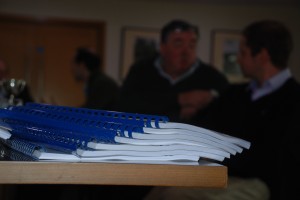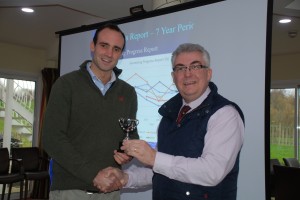In the week that DEFRA announced that two-thirds of UK farmers run their businesses without cashflow or plan, the group of farmers that scrutinise cost and efficiency of every machinery move they make met again to review their benchmarked results for harvest 2017.
Not afraid of the detail

Antony Pearce, like all JVFG members, opens machinery and system choice to scrutiny to improve performance
The Joint Venture Farming group (JVFG) member businesses – now eleven and growing over 17500 arable hectares – met in East Hampshire in the area farmed by JVFG member EC Drummond. A room full of joint venture farmers faced up to their latest year’s benchmarked data to assess every aspect of their machinery and labour cost performance.
Shifting cropping and changing costs
JVFG consultant Jamie Gwatkin revealed several trends in the group benchmarked analysis. Over the last three years there have been significant declines in acreage of wheat, from 50% to 41%, and oilseed rape, from 25% to 15% of the total area. Infestation of flea beetle and black grass are some of the causes.
For the first time, establishment costs have risen across the group. Variations exist with the group on work rates for both primary and secondary cultivations and at drilling too. Pelham Farming achieved the highest overall work rate. Total cost per hectare for all operations of, for example, winter wheat showed businesses recording labour and machinery costs at £400/hectare while others are at £100ha less. It is that £300/ha that becomes the target for all, no matter what soil type or kit system.
Combination of combine performance
Alignment of member business performance is taking place in some areas, for example with the costs of combining.

JVFG consultant Jamie Gwatkin pointed out the ways benchmarked member costs are progressing as well as the improvements yet to make.
“It is good that particularly with combine costs members’ performances are coming closer together. They are not as different as they were”, says Jamie Gwatkin, “it means members picking up and learning the lessons from each other and putting them into practice which is great.”
As usual peer-leading performance meant prizes. Olly Hammond won the cup for best combine costs. Tim Merry, now the new chairman of JVFG, won the cup for lowest establishment costs. Chis Middleditch won the cup for lowest cost per tonne on winter wheat and oilseed rape.
Tools for monitoring and saving

Bespoke reports for each JVFG member business allow further analysis of improvements to make and how to achieve them.
The new JVFG data collection system is coming online. The developer, Richard Green from Trickyweb, explained how it will ease data entry and allow realtime comparisons across the year. Continuing with the theme of digital innovation, Daniel Jolly, co-founder and Business Development Manager for Yagro, wanted to inspire the room with the ways that farm businesses can reduce costs by where and how they buy their supplies. He gave a demonstration of how the new buying and cost comparison platform can significantly shave costs on key inputs from fuel to agchem products.
Mind that benchmarked gap
The meeting ended with each member business being given their own individual report for Harvest 2017. Tables show with traffic light ‘at a glance’ results for each aspect of labour and machinery costs. This guides eyes and minds to whether the business is at benchmark (yellow),10% above (green) or10% below (red).
With new members business data now in the group that is adding yet more data and comparisons for analysis. They are also bringing to the table new ideas as well, to the benefit of the while group.
More joint ventures and new tools in 2018
Joint ventures are most certainly on the radar for many farmers for 2018. “It’s not easy. It is something that you have to work at”, commented Jamie Gwatkin. “But it is one thing that is going to make farming more sustainable.”
With new joint ventures already applying to join JVFG there will be new faces and businesses around the table the next time JVFG meets which will be in Spring 2018.


